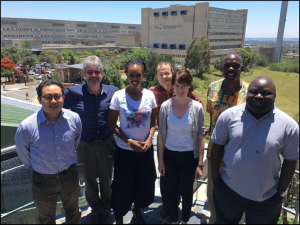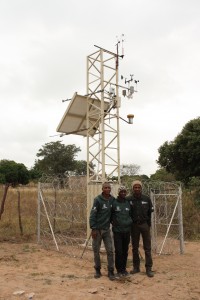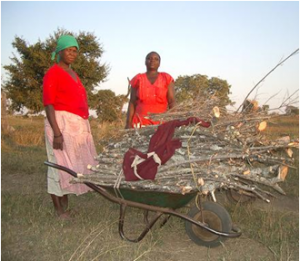Theme leaders: Prof Mark Collinson and Prof Wayne Twine
Problem statement
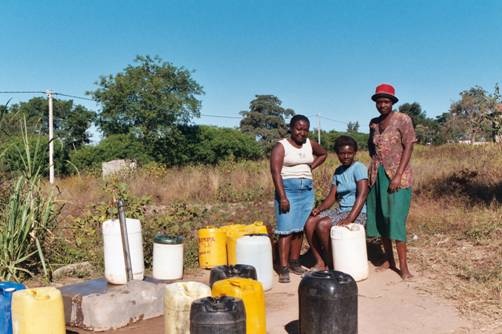 Poverty remains an unresolved burden for the majority of rural households, with significant negative implications for health and well-being. While ill-health, food insecurity, and malnutrition are outcomes of poverty on the one hand, they are also constraints on the ability of households to escape poverty on the other. Poverty also heightens household vulnerability to the impacts of shocks and stresses such as HIV/AIDS and environmental change, to which rural households are increasingly being exposed. Nevertheless, some households do manage to escape or remain out of poverty, even in the face of shocks and stresses, while others do not. Aspects of rural livelihoods such as social connections, use of the local natural environment, and engagement in off-farm livelihood strategies such as labour migration, are well studied and have been shown to have positive implications for health and well-being. Nevertheless, household, community and environmental level factors which promote or constrain household resilience and the ability to ascend out of poverty are complex, interactive, and remain poorly understood. Deeper understanding of household livelihoods in this context is thus essential for informing policy and programmes aimed at promoting health and social development in transitioning rural societies which are exposed to multiple shocks and stresses
Poverty remains an unresolved burden for the majority of rural households, with significant negative implications for health and well-being. While ill-health, food insecurity, and malnutrition are outcomes of poverty on the one hand, they are also constraints on the ability of households to escape poverty on the other. Poverty also heightens household vulnerability to the impacts of shocks and stresses such as HIV/AIDS and environmental change, to which rural households are increasingly being exposed. Nevertheless, some households do manage to escape or remain out of poverty, even in the face of shocks and stresses, while others do not. Aspects of rural livelihoods such as social connections, use of the local natural environment, and engagement in off-farm livelihood strategies such as labour migration, are well studied and have been shown to have positive implications for health and well-being. Nevertheless, household, community and environmental level factors which promote or constrain household resilience and the ability to ascend out of poverty are complex, interactive, and remain poorly understood. Deeper understanding of household livelihoods in this context is thus essential for informing policy and programmes aimed at promoting health and social development in transitioning rural societies which are exposed to multiple shocks and stresses
Migration, Urbanization and Health in a Transition Setting – Migrant Health Follow-Up Study (MHFUS)
Website: https://www.brown.edu/research/projects/migration-and-health/migration-and-health-follow-study-mhfus
Principal Investigators: Associate Professor Mark Collinson (Wits); Professor Michael White (Brown University). Co-Investigators: Dr Carren Ginsburg (Wits); Associate Professor Francesc Xavier Gómez-Olivé (Wits); Professor Stephen Tollman (Wits); Professor Andrew Foster (Brown University); Professor Mark Lurie (Brown University); Professor Stephen McGarvey (Brown University)
Funder: National Institutes of Health (US); Grant 1R01HD083374, “Migration, Urbanization and Health in a Transition Setting.”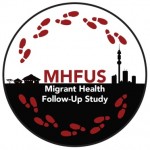 Internal migration refers to the movement of people within a country, often to urban areas in search of work, but returning to a rural home periodically. This is a significant feature of the South African economy. Despite such prevalent mobility within the country, the impact of migration and urbanization on health is little understood. The Migrant Health Follow-Up Study (MHFUS), nested within the Agincourt health and socio-demographic surveillance system platform, aims to understand the relationships between migration, urbanization and health in an environment undergoing health, demographic and social transition. The research is focused on how migration and urbanization change risk factors for health conditions and whether migration creates barriers to accessing treatment and continuity of health care.
Internal migration refers to the movement of people within a country, often to urban areas in search of work, but returning to a rural home periodically. This is a significant feature of the South African economy. Despite such prevalent mobility within the country, the impact of migration and urbanization on health is little understood. The Migrant Health Follow-Up Study (MHFUS), nested within the Agincourt health and socio-demographic surveillance system platform, aims to understand the relationships between migration, urbanization and health in an environment undergoing health, demographic and social transition. The research is focused on how migration and urbanization change risk factors for health conditions and whether migration creates barriers to accessing treatment and continuity of health care.
The MHFUS cohort includes rural-origin residents (non-migrants) of the Agincourt study area, and internal migrants who leave the study area in rural Mpumalanga, usually to access employment in the Gauteng province. We are following-up an initial cohort of 3964 individuals aged 19–40 over 5 data collection waves spanning the period 2017-2023. The study is currently in its fourth wave of data collection and has achieved high cohort retention over time.
The study has collected longitudinal data that allow for analyses of patterns and changes in key health and socio-economic variables over time. We have found important differences in health and socioeconomic outcomes by migration status and by gender. For example, women migrants display high blood pressure in contrast with rural Agincourt residents, and migrants are less inclined to use health services in destinations as compared to those who have not moved. Conversely, over the pandemic period of 2020-2021, we observed worsening socioeconomic circumstances for Agincourt resident participants (disproportionately women) and return migrants, while continuing migrants reported better socioeconomic outcomes. Findings from the MHFUS have direct policy implications for South Africa in shedding light on the populations most at risk of developing chronic illnesses, like hypertension, and revealing whether migrants have particular health risks or vulnerabilities.
The Multi-centre Analysis of the Dynamics of Internal Migration And Health (MADIMAH) project Oct, 2017
Collaboration with INDEPTH Migration, Urbanisation and Health Working Group
The MRC/Wits Agincourt team is involved in collaborative research with the INDEPTH Network in the area of migration and health. The INDEPTH Migration, Urbanisation and Health Working Group (MUHWG) committee members are Professor Mark Collinson (Group Leader: MRC/Wits Agincourt Unit), Professor Philippe Bocquier (Université Catholique de Louvain, Belgium), Dr Carren Ginsburg (MRC/Wits Agincourt Unit) and Dr Donatien Béguy (UN Habitat). The Working Group has two substantive aims 1) to showcase migration by studying determinants; 2) to understand how migration affects health and wellbeing. Technical aims of the Working Group include the use of HDSS data to run Event History (longitudinal) models through developing widely applicable data transformations and analytic methods for application in single centre and multi-centre analyses.
The MUHWG has focused in the past few years on progressing the Multi-centre Analysis of the Dynamics of Internal Migration And Health (MADIMAH) initiative. Following the publication of a peer-reviewed volume in 2009 entitled “The dynamics of migration, health and livelihoods. INDEPTH Network perspectives”. Collinson, M., Adazu, K., White, M., and Findley, S. (eds.) Surrey: Ashgate, the MADIMAH project was launched in 2011. The aim of MADIMAH is to produce comparative studies on questions concerning migration and health using Health and Demographic Surveillance Systems (HDSS) data from INDEPTH member centres located in Africa and Asia.
The following INDEPTH HDSS member centres are currently participating in MADIMAH research activities: Nouna HDSS, Nanoro HDSS and Ouagadougou HDSS (Burkina Faso); Kilifi HDSS, Kisumu HDSS and Nairobi HDSS (Kenya); Manhica HDSS (Mozambique); and Agincourt HDSS and the Africa Health Research Institute (South Africa).
The MADIMAH project comprises three streams of multi-centre research: the first focuses on determinants of migration, in particular the relationship between internal migration and human capital (MADIMAH 1). The second encompasses a study of migration, mortality and epidemiological transition (MADIMAH 2). A new stream (MADIMAH 3), which commenced in 2016, involves a study of child mortality, migration, parental presence and household composition in Africa and Asia.
MADIMAH 1 research activities have included:
1) A multi-centre research paper on education as a determinant of internal migration in 8 HDSSs published in Demographic Research (Ginsburg, C., Bocquier, P., Béguy, D., Afolabi, S., Augusto, O., Derra, K., Odhiambo, F., Otiende, M., Soura, A., Zabre, P., White, M.J., Collinson, M.A., (2016). Human capital on the move: Education as a determinant of internal migration in selected INDEPTH surveillance populations in Africa. Demographic Research. 34(30): 845-884. DOI: 10.4054/DemRes.2016.34.30);
2) A data release on INDEPTH iShare data repository Multi-centre Analysis of the Dynamics of Internal Migration and Human Capital in Selected INDEPTH Centres in Sub-Saharan Africa – Release 2016. Provided by the INDEPTH Network Data Repository. 2016. <http://www.indepth-network.org>. doi:10.7796/INDEPTH.GH004.MIG.2014.v1.;
3) A training manual detailing MADIMAH data management techniques aimed at data managers, analysts and students (Bocquier, P., Ginsburg, C., Herbst. K., Sankoh, O., Collinson, M.A. (2017). A training manual for Event History Data Management using Health and Demographic Surveillance System data. BMC Research Notes. 10: 224. DOI 10.1186/s13104-017-2541-9).
MADIMAH 2 research activities include:
1) A multi-centre publication on migration and all-cause mortality in 9 HDSS centres published in Social Science & Medicine (Ginsburg, C., Bocquier, P., Béguy, D., Afolabi, S., Augusto, O., Derra, K., Herbst. K., Lankoande, B., Odhiambo, F., Otiende, M., Soura, A., Wamukoya, M., Zabre, P., White, M.J., and Collinson, M.A. (2016). Healthy or unhealthy migrants? Identifying internal migration effects on mortality in Africa using Health and Demographic Surveillance Systems. Social Science & Medicine. 164 (2016), 59-73.).
2) A research paper examining internal migration and mortality by cause of death in 4 HDSSs (Africa Centre, Agincourt, Kisumu, Nairobi) in Kenya and South Africa. The write-up of this paper is currently underway.
The MADIMAH project has a strong capacity development and training focus aimed at:
– Consolidating and standardising HDSS centre databases to prepare data for multi-centre, comparative analyses
– Training HDSS scientists in the statistical programmes and analytic methods (event history analysis) required to perform analyses
– Familiarising HDSS scientists with literature on migration, mortality and the epidemiological transition
– Guiding discussions on the interpretation of analytic findings
MADIMAH Workshop participants November 2016 (L-R): Andrew Tomita, Mark Collinson, Marylene Wamukoya, Philippe Bocquier, Carren Ginsburg, David Obor, Sulaimon Afolabi
Training has been facilitated through a series of workshops involving scientists from participating HDSS centres. The workshops have aimed to train participants in methods and analytic techniques to apply to single-centre publications on migration, and to contribute as co-authors to multi-centre publications.
Household structure and vulnerability/resilience
Collaboration with Maryland, Missouri, Colorado at Boulder and Brown Universities, USA
The life-cycle of households are changing due to changing migration patterns and increasing mortality of prime age adults. This cluster uses qualitative studies triangulated with surveillance-based analyses to investigate changing household structure and composition. Changing social roles of fathers, mothers and older adults are examined as well as the importance of meaningful links to networks beyond the household. Migration of under-five children is significantly related to household poverty. There is an important household role for women over 60 years shown by the fact that 15% of households had a at least one fostered child and 6% at least one maternal orphan, while 27% of households with an over sixty year old woman included a fostered child and 16% a maternal orphan.
A high-tech scientific research installation has been erected on the edge of Agincourt village. It is called an Eddy Covariance Flux Tower.
This flux tower was erected as part of the Adaptive Resilience of Southern African Ecosystems (ARS AfricaE) project under the Science Partnerships for the Assessment of Complex Earth System Processes (SPACES) programme. Prof Wayne Twine of Wits University are part of a research consortium that includes the Council for Scientific and Industrial Research (CSIR) and various South African and German Universities collaborating on the ARS AfricaE project.
This project investigates the coupled carbon and water cycles of natural and disturbed savanna ecosystems in southern Africa. It aims to deepen the knowledge on how the natural environment functions in rural communities in southern Africa. This knowledge is crucial for understanding the link between ecosystem and climate, and how changes in land use may impact the climate in the future.
The technique used is called the eddy covariance technique, which measures how much carbon dioxide (CO2), water vapour, and energy moves between the land surface and the atmosphere as well as other measurements. The flux tower houses a range of very sophisticated equipment used to make these measurements. The Agincourt eddy covariance flux tower is one five erected in South Africa and was erected on the southern edge of Agincourt village in 2015 It enables the collection of ecological flux data in a human-modified landscape.
The Natural Environment and Resilience – SUCSES (Sustainability in Communal Socio-Ecological Systems) Collaboration with APES (School of Animal, Plant and Environmental Sciences) at Wits, and University of Colorado at Boulder, USA.
Previous work shows that food security is threatened by adult mortality, and that greater reliance on natural resources is often a coping response of households impacted by such crises. In this longitudinal study, we examine how natural resources are used to offset the impacts of household shocks, the degree to which this buffers households against adversity, and how environmental change might erode the resilience of households. A cohort of 600 households within the HDSS was established in 2010 to examine livelihood strategies and outcomes. This is linked with environmental surveillance, both climatic and ecological, in the study villages. In 2014, the fifth annual round of the household livelihoods survey was completed.


